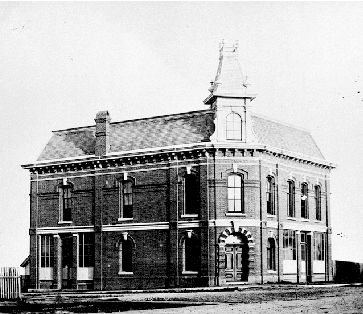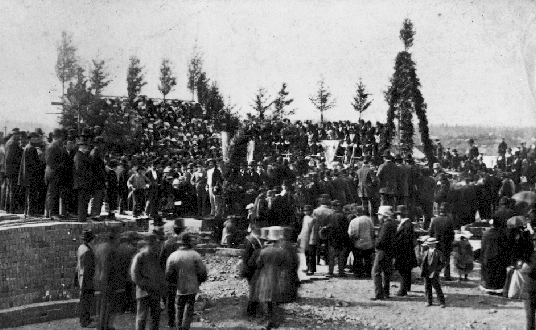The Masonic Temple
"Unless our order were good and our calling honorable we should not have existed for so many centuries, nor should we have been honored with the patronage of so many illustrious men in all ages…" - Most Worshipful Grand Master, Eli Harrison, Senior, April 22, 1878 at the cornerstone ceremony for Victoria's Masonic Temple

The Victoria Masonic Temple circa 1880. The architectural plans were drawn up by Victoria resident and Freemason John Teague. Teague was responsible for the design of many Victoria landmarks, including: Victoria City Hall, Church of our Lord, and the 1886 addition to St. Ann's Convent School.
The evolution of the Masonic fraternity in Victoria paralleled the rapid growth and industrialization of the city. With an influx of migrants arriving in Victoria in 1858 en route to the Fraser River gold rush, the cultural and environmental landscape of the coastal community underwent significant transformation. The fraternity of Free and Accepted Masons was one of the first organizations to assemble in the city at that time. With historic roots in Masonic craftsmanship, the organization facilitated professional advancement and business success for many of the men who colonized the Pacific Coast of British Columbia.
The first formal meeting of Victoria Lodge No. 1085 occurred on March 19th, 1859.1 Referencing the conditions under which the Masonic community developed in Victoria, official Masonic communication states that “…miners and adventurers from every part of the Western Hemisphere made their rendezvous on the flats at James Bay, and on either side of the Johnson Street ravine. Gold – that “Magic Talisman,” had drawn them to Victoria, and it was among such surroundings, and in such exciting times, that Victoria Lodge No. 1085 was started on its Masonic journey.”2
Through the 1860s and 1870s, members of Victoria's Masonic Lodges were called on to lay many of the city's cornerstones with proper Masonic honours. Although the Masonic fraternity conducted business behind closed doors, the cornerstone ceremonies were public events that mediated the interaction of the broader community with some of Victoria's most eminent citizens. That these eminent citizens were also Masons was no coincidence. The prestige of membership in a fraternal organization like the Masonic Order was important in constructing and maintaining a proud, professional identity.
The symbolic importance of the cornerstone could not be underestimated in Victorian times; because it was the main point from which to start the building, it had to be laid correctly for all that followed to be correct. During the laying of the cornerstone for the Mortuary Chapel of the Masonic Cemetery at Sapperton in 1872, Most Worshipful Grand Master Israel Wood Powell noted, “We admit into our Order only such as are reported to be good men and true, of a lawful age, good morals and sound judgment. We meet upon the level, and are constantly instructed to square our conduct by the principles of morality and virtue.”3

The laying of the cornerstone for the Masonic Temple on the corner of Douglas and Fitzgard streets was a significant occasion for Victoria's Masonic members. The procession of Masonic officers and visiting Brethren was most imposing, with members carrying banners, architectural plans, ceremonial offerings, Masonic regalia, Craft tools, a volume of Sacred Law, and other objects and texts of special utility and significance.5
Eli Harrison, Sr., the Most Worshipful Grand Master of the Grand Lodge of British Columbia, opened the ceremony by acknowledging and honouring the law and custom of the country, the Queen, and God - the “Great Architect of the Universe.”4 This compliance with established custom and ritual suggests reasons for the structured precision that is evident in all of the cornerstone ceremonies featured on this website. Victoria's first Masons were new to the lay of the land, but they were governed by an ancient body of tradition. They were quick to accommodate the challenges posed by colonial life (as in the construction of Masonic aprons by the tent maker), but the practices and ceremonies retained much of the dignity and formality characteristic of the broader Masonic community.
The Cornerstone
Time Capsule Contents:- Scroll [that detailed a speech read by the Grand Secretary on the day of the laying of the cornerstone.]
- Copy of “Proceedings to organize and 1st Grand Communication of Grand Lodge of British Columbia with constitution proceedings of 6th annual communication (1877.)
- Copy of Canadian Craftsman.
- Copy of Daily British Colonist
- Copy of Daily Victoria Standard.
- Coins
- List of Grand Lodge officers for 1878.
Click to learn more about Eli Harrison Sr.
Click to view Masonic References






